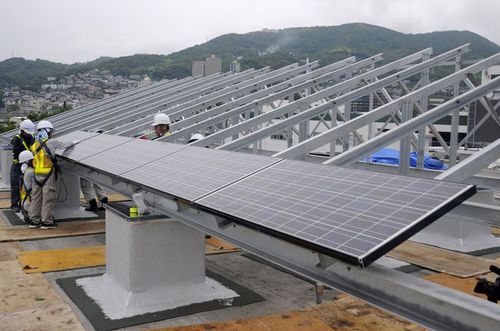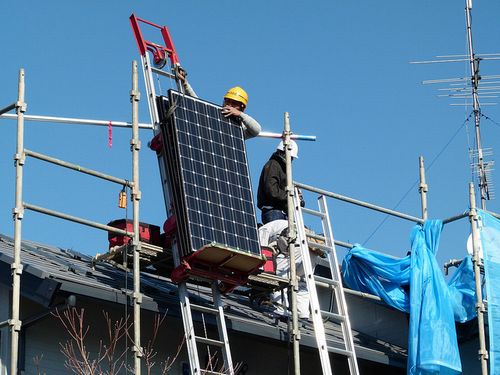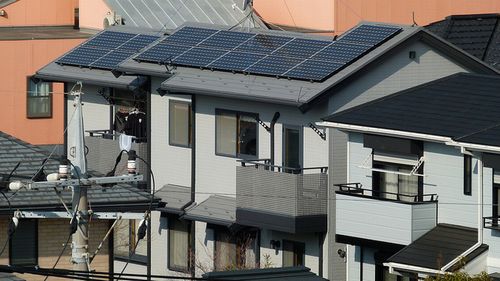May 13, 2015
"Rooftop Leasing" Photovoltaic Generation Spreading across Japan
Keywords: Newsletter Renewable Energy
JFS Newsletter No.152 (April 2015)

Image by Official U.S. Navy Page Some Rights Reserved.
On the initiative of local governments in Japan, photovoltaic generation business projects have been conducting rooftop leasing to achieve effective use of building rooftops. Such projects have been gaining ground nationwide, having attracted attention as a new business model after introduction of a feed-in tariff (FIT) scheme in July 2012. In fact, approximately 15 percent of Japan's 47 prefectures embarked on rooftop leasing projects in fiscal 2012, the first year of the FIT scheme. The percentage of prefectural governments starting rooftop leasing projects has continued to increase, reaching approximately 50 percent in fiscal 2014.
Rooftop leasing schemes work as follows. Power generation companies rent rooftops from the owners of suitable facilities and install solar panels at their expense. Then they obtain income by selling electricity under the FIT scheme, while paying rent on the rooftops to the facilities' owners. The FIT scheme requires electric power companies to buy electricity generated by solar panels with an output of 10 kilowatts or more at a fixed price for 20 years. For this reason, the rooftop leasing period is generally 20 years.
The biggest advantage for the facilities' owners is that unused space can be turned into an asset that generates income without further investment. There are additional advantages, including waterproofing work conducted when solar panels are installed that prolongs the life of roofs and houses, and a power source from the installed solar panels that may come in handy in an emergency.
A big advantage for the power generation companies is that the initial investment is less than would be needed to buy land for situating solar panels. Although they pay rent, thanks to the FIT scheme, they gain income for 20 years or more.
Kanagawa Prefecture, our first example, launched a rooftop leasing project in July 2012, ahead of other prefectures. To promote installation of solar panels in public facilities and activate the local economy by encouraging local solar panel installation and other companies to participate in the project, the prefecture started with rooftop leasing of facilities it owned itself.
In September 2012, the prefecture started a matching project for rooftop leasing, targeting private facilities, and in fiscal 2014, it started matching land leasing in addition to rooftop leasing. In October 2014, it started a matching project for rooftop leasing involving multiple houses, promoting further propagation of solar panels.
To make rooftop leasing profitable as a business, an output of 10 kilowatts or more is required, and thus an area of approximately 100 square meters is necessary even if the solar panels are installed on inclined roofs, whose power generating efficiency is higher than that on the ground. Since the roofs of most private houses are less than 100 square meters in area, the scheme would not work if each household leased the roof of its house individually. Gathering house owners, though, and matching them with power generation companies has enabled previously unused private houses' rooftops to be used effectively.
Since the 20-year contract period of rooftop leasing is so long, various issues are likely to arise that need to be dealt with. These include problems such as rainwater leakage or necessary repairs due to aging of the buildings. Therefore, the facility owner and power generation company need to determine in advance how they will deal with potential problems before signing the contract. The complications involved in such procedures, however, present a higher threshold, in a sense, to actually joining the program for those who are interested in it. In order to lower this threshold, the Kanagawa Prefectural Government decided to provide assistance for facilitating the contract-making procedure by presenting a sample contract and organizing seminars.
The rooftop leasing business model for solar power generation pioneered by the Kanagawa Prefectural Government is now being utilized nationwide. The government of Miyagi Prefecture, one of the areas massively damaged by the Great East Japan Earthquake on March 11, 2011, leases rooftops of public housing built for disaster victims who lost their homes.
Disaster public housing was developed by municipalities in the prefecture, but the prefectural government organized the rooftop leasing project and made an open call for proposals from power generation companies. As of the end of September 2014, the open call for fiscal 2014 had recruited 546 buildings in 53 districts of 16 municipalities, the design phase of which had been completed in all cases. It is now leasing rooftops with a total planned output of about 4,300 kilowatts.
Committee members, who include municipality employees and outside experts, select power generation companies through screening. With the conclusion of agreements for implementing solar power generation programs between the prefectural government, municipalities and selected companies, the municipalities lease the rooftops of disaster public housing to the companies. The companies generate power utilizing the public housing rooftops and pay usage fees (rent) for the rooftops to the municipalities for more than 20 years, including the period of solar panel installation and removal work. They also make arrangements for residents of the public housing whose rooftops are being leased to use the power generated by their rooftops free of charge in the event of a blackout.
Another example is an initiative by the Nagano Prefectural Government, which launched Renewable Energy Shinshu-net, a collaborative network connecting citizens, businesses, universities and administrative bodies. Under the Ohisama Bunch-of-Sun Mega-Solar Project, a solar rooftop leasing project created by the prefectural government, Renewable Energy Shinshu-net, power generation companies and the prefectural government concluded a three-party agreement, aiming to promote renewable energy usage in the prefecture.
This project promotes dispersed megawatt power generation by utilizing the space not only of large roofs but also small rooftops, organizing rooftops of both public and private buildings in clusters dispersed across the prefecture, like grapes on a grapevine. A part of the prefecture's revenue from electric power sales is allocated to cover the project's cost so as to return the benefit to activities promoting renewable energy. In addition, Renewable Energy Shinshu-net analyzes and organizes technical information regarding the project and has released the project manual to the public to encourage wide use of the know-how from the project across the prefecture.
The public is also being allowed access to information on the amount of electricity generated at different installation angles at a solar power generation laboratory operated by a private company. Moreover, the prefecture is disclosing installation methods by conducting tours of solar power installation sites just after installation work starts, during the work, and after completion of the work. By actively transmitting the know-how for the installation of the solar panels, the prefecture intends to encourage local companies to participate in the project, as well as local municipalities to become roof owners.
In Ueda City, Nagano Prefecture, a non-profit organization (NPO) Ueda Citizen Energy has taken the initiative in a roof leasing program. This program, called Ainorikun (meaning "car pooler" in Japanese), was designed a little differently from the programs described above.
There are three ways to participate in the Ainorikun program. One is to participate as a "roof owner," who lends space from his/her house's rooftop. Roof owners are required to install solar panels with a capacity that satisfies their daytime household electricity use at their own expense. In this way, roof owners need to make an initial investment, but if they install solar panels for their own use together with panels in spaces for rent, the per-unit price of the solar panels is cheaper. In addition, ownership of the panels installed in spaces for rent is transferred to the owner of those spaces after 12 years.

Image by CoCreatr Some Rights Reserved.
The second way to participate is as a "panel owner," who invests jointly in the installation of solar panels. By bearing the installation cost, people from anywhere in Japan can participate in the program as panel owners. The minimum investment is 100,000 yen (U.S.$841) and can be increased freely in units of 50,000 yen. In this system, panel owners can profit from revenue earned by selling power to a utility for a 10-year contract term. After that, for two years, the revenue is allocated to operating expenses for Ueda Citizen Energy, and then the right to receive the revenue is transferred to the roof owners.
The third way to participate is as a supporter of the program by paying an annual membership fee in units of 3,000 yen. Supporters do not profit because they do not engage directly in the program, but they can contribute to the promotion of natural energy.
Roof leasing initiatives were first undertaken by local governments and have gradually expanded with the involvement of private businesses and citizens. On the other hand, Japan is facing a couple of challenges: the promotion of renewable energy sources has been weighted toward PV power generation, and the introduction of other renewable energy sources has not proceeded well. It is hoped that the expansion of roof leasing initiatives will help people create new ideas, leading eventually to the introduction of a variety of renewable energy sources.

Image by CoCreatr Some Rights Reserved.
Written by Nobuhiro Tanabe
Related
"JFS Newsletter"
- 'Good Companies in Japan' (Article No.4): 'Eightfold Satisfaction' Management for Everyone's Happiness
- "Nai-Mono-Wa-Nai": Ama Town's Concept of Sufficiency and Message to the World
- 'Yumekaze' Wind Turbine Project Connects Metro Consumers and Regional Producers: Seikatsu Club Consumers' Co-operative
- Shaping Japan's Energy toward 2050 Participating in the Round Table for Studying Energy Situations
- 'Good Companies in Japan' (Article No.3): Seeking Ways to Develop Societal Contribution along with Core Businesses


